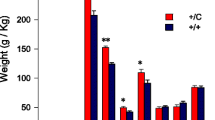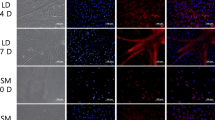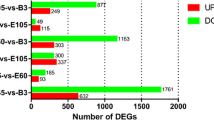Abstract
The insulin-like growth factor I (IGF-I)-calcineurin (CaN)-NFATc signaling pathways have been implicated in the regulation of myocyte hypertrophy and fiber-type specificity. In the present study, the expression of the CnAα, NFATc3, and IGF-I genes was quantified by RT-PCR for the first time in the breast muscle (BM) and leg muscle (LM) on days 13, 17, 21, 25, and 27 of embryonic development, as well as at 7 days posthatching (PH), in Gaoyou and Jinding ducks, which differ in their muscle growth rates. Consistent expression patterns of CnAα, NFATc3, and IGF-I were found in the same anatomical location at different development stages in both duck breeds, showing significant differences in an age-specific fashion. However, the three genes were differentially expressed in the two different anatomical locations (BM and LM). CnAα, NFATc3, and IGF-I messenger RNA (mRNA) could be detected as early as embryonic day 13 (ED13), and the highest level appeared at this stage in both BM and LM. Significant positive relationships were observed in the expression of the studied genes in the BM and LM of both duck breeds. Also, the expression of these three genes showed a positive relationship with the percentage of type IIb fibers and a negative relationship with the percentage of type I fibers and type IIa fibers. Our data indicate differential expression and coordinated developmental regulation of the selected genes involved in the IGF-I-calcineurin-NFATc3 pathway in duck skeletal muscle during embryonic and early PH growth and development; these data also indicate that this signaling pathway might play a role in the regulation of myofiber type transition.




Similar content being viewed by others
References
Bandman E, Rosser BWC (2000) Evolutionary significance of myosin heavy chain. Microsc Res Tech 50:473–491
Barjot C, Navarro M, Cotton ML, Garandel V, Bernardi H, Bacou F, Barenton B (1996) Rabbit slow and fast skeletal muscle-derived satellite myoblast phenotypes do not involve constitutive differences in the components of the insulin-like growth factor system. J Cell Physiol 169:227–234
Barnard EA, Lyles JM, Pizzey JA (1982) Fibre types in chicken skeletal muscles and their changes in muscular dystrophy. J Physiol 331:333–354
Berchtold MW, Brinkmeier H, Muntener M (2000) Calciumion in skeletal muscle: its crucial role for muscle function, plasticity, and disease. Physiol Rev 80:1215–1265
Booth FW, Thomason DB (1991) Molecular and cellular adaptation of muscle in response to exercise: perspectives of various models. Physiol Rev 71:541–585
Chin ER, Olson EN, Richardson JA, Yano Q, Humphries C, Shelton JM, Wu H, Zhu WG, Bassel-Duby R, Williams RS (1998) A calcineurin-dependent transcriptional pathway controls skeletal muscle fiber type. Genes Dev 12:2499–2509
China National Commission of Animal Genetic Resources (2011) Animal genetic resources in China-Poultry. China Agriculture Press, Beijing
Condon K, Silberstein L, Blau HM, Thompson WJ (1990) Development of muscle fiber types in the prenatal rat hindlimb. Dev Biol 138:256–274
Crabtree GR (1999) Genetic signals and specific outcomes: signaling through Ca2+, calcineurin, and NFAT. Cell 96:611–614
Delling U, Tureckova J, Lim HW, Windt JD, Rotwein P, Molkentin JD (2000) A calcineurin-NFATc3-dependent pathway regulates skeletal muscle differentiation and slow myosin heavy-chain expression. Mol Cell Biol 20:6600–6611
Depreux FFS, Scheffler JM, Grant AL, Bidwell CA, Gerrard DE (2010) Molecular cloning and characterization of porcine calcineurin-α subunit expression in skeletal muscle. J Anim Sci 88:562–571
Dupont J, Holzenberger M (2003) Biology of insulin-like growth factors in development. Birth Defects Res Part C 69:257–271
Friday BB, Mitchell PO, Kegley KM, Pavlath GK (2003) Calcineurin initiates skeletal muscle differentiation by activating MEF2 and MyoD. Differentiation 71:217–227
Hudson MB, Price SR (2013) Calcineurin: a poorly understood regulator of muscle mass. Int J Biochem Cell Biol 45:2173–2178
Lefaucheur L, Milan D, Ecolan P, Le Callennec C (2004) Myosin heavy chain composition of different skeletal muscles in Large White and Meishan pigs. J Anim Sci 82:1931–1941
Long YC, Glund S, Garcia-Roves PM, Zierath JR (2007) Calcineurin regulates skeletal muscle metabolism via coordinated changes in gene expression. J Biol Chem 282:1607–1614
Matsakas A, Patel K (2009) Skeletal muscle fibre plasticity in response to selected environmental and physiological stimuli. Histol Histopathol 24:611–629
Matsuoka Y, Inoue A (2008) Controlled differentiation of myoblast cells into fast and slow muscle fibers. Cell Tissue Res 332:123–132
Mitchell PO, Mills ST, Pavlath GK (2002) Calcineurin differentially regulates maintenance and growth of phenotypically distinct muscles. Am J Physiol Cell Physiol 282:984–992
Motta VF, de Lacerda CAM (2012) Beneficial effects of exercise training (treadmill) on body mass and skeletal muscle capillaries/myocyte ratio in C57BL/6 mice fed high-fat diet. Int J Morphol 30:205–210
Musaro A, Rosenthal N (1999) Maturation of the myogenic program is induced by postmitotic expression of insulin-like growth factor I. Mol Cell Biol 19:3115–3124
Musaro A, McCullagh KJ, Naya FJ, Olson EN, Rosenthal N (1999) IGF-1 induces skeletal myocyte hypertrophy through calcineurin in association with GATA-2 and NFATc1. Nature 400:581–5
Parsons SA, Wilkins BJ, Bueno OF, Molkentin JD (2003) Altered skeletal muscle phenotypes in calcineurin Aa and Ab gene-targeted mice. Mol Cell Biol 23:4331–4343
Picard B, Lefaucheur L, Berri C, Duclos MJ (2002) Muscle fibre ontogenesis in farm animal species. Reprod Nutr Dev 42:415–431
Rao A, Luo C, Hogan PG (1997) Transcription factors of the NFAT family: regulation and function. Annu Rev Immunol 15:707–747
Rushbrook JI, Huang J, Weiss C, Yao TT, Siconolfi-Baez L (1998) Protein and mRNA analysis of myosin heavy chains in the developing avian pectoralis major muscle. J Muscle Res Cell Motil 19:157–168
Semsarian C, Sutrave P, Richmond DR, Graham RM (1999a) Insulin-like growth factor (IGF-I) induces myotube hypertrophy associated with an increase in anaerobic glycolysis in a clonal skeletal-muscle cell model. Biochem J 339:443–451
Semsarian C, Wu MJ, Ju YK, Marciniec T, Yeoh T, Allen DG, Harvey RP, Graham RM (1999b) Skeletal muscle hypertrophy is mediated by a Ca2+-dependent calcineurin signaling pathway. Nature 400:576–580
Torella JR, Fonces V, Palomeque J, Viscor G (1996) Capillarity and fiber types in locomotory muscles of wild mallard ducks (Anas platyrhynchos). J Comp Physiol B 166:164–177
Ulrike D, Jolana T, Hae WL, Leon JDW, Peter R, Jeffery DM (2000) A calcineurin-NFATc3-dependent pathway regulates skeletal muscle differentiation and slow myosin heavy-chain expression. Mol Cell Biol 20:6600–6611
Wegner J, Albrecht E, Fielder I, Teuscher F, Papstein HJ, Ender K (2000) Growth and breed-related changes of muscle fiber characteristics in cattle. J Anim Sci 78:148--1496
Acknowledgments
This research was supported by the National Natural Science Foundation of China (31172194) and Key Technology Support Program of Jiangsu Province (BE2014362, BE2012460).
Author contributions
Conceived and designed the experiments: HFL JTS. Performed the experiments: JTS YJS WJX. Analyzed the data: JTS YJS SC WTC. Contributed reagents/materials/analysis tools: JTS WFC CS. Wrote the paper: HFL JTS.
Author information
Authors and Affiliations
Corresponding author
Additional information
Communicated by Andreas Kispert
Jingting Shu and Huifang Li contributed equally to this work.
Rights and permissions
About this article
Cite this article
Shu, J., Li, H., Shan, Y. et al. Expression profile of IGF-I-calcineurin-NFATc3-dependent pathway genes in skeletal muscle during early development between duck breeds differing in growth rates. Dev Genes Evol 225, 139–148 (2015). https://doi.org/10.1007/s00427-015-0501-8
Received:
Accepted:
Published:
Issue Date:
DOI: https://doi.org/10.1007/s00427-015-0501-8




